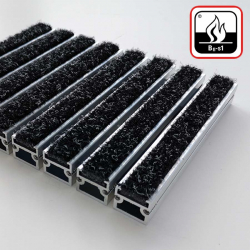How to better understand ERP classification?
The term ERP is often used to describe an establishment open to the public. In fact, there are different types of ERP, classified according to 2 criteria: number of employees and sector of activity. This is known as ERP classification.
In this article, NeoSol explains what an ERP is, what measures must be respected, and how to understand their classification.
What is an ERP?
ERP is short for "établissement recevant du public" or "establishment receiving the public". It refers to a building, premises or enclosure into which visitors may enter free of charge or for a fee. In French law, ERP refers to private or public places open to the public. Defined by article R 123-3 of the code de la construction et de l'habitation (French building and housing code), it sets out rules for health and safety at work, with the aim of protecting all persons entering an ERP, including personnel.
What are ERP regulations?
ERP buildings are subject to a number of different standards, depending on the type and category of the establishment. These regulations are, in a way, the steps to follow to welcome the public in complete safety and serenity. Yes, establishments open to the public must comply with certain protocols before they can welcome anyone.
These rules enable ERP :
- comply with the requirements of article R 123-3,
- equip themselves with collective and individual protective equipment such as professional floor mats,
- prepare for and prevent fire risks,
- alert staff and visitors in the event of a fire,
- facilitate evacuation, if necessary.
- to alert the emergency services in the event of danger.
Who inspects ERP buildings, and what measures need to be taken?
Before ERP buildings are built, they are inspected by a safety commission, which ensures that these rules are respected and that fire prevention measures are in place. Every ERP is required to keep a safety register detailing the various interventions and technical checks carried out in your establishment. Any work carried out, as well as any risk and workplace safety training received by staff, must also be recorded. Finally, clear instructions and an evacuation plan in the event of fire must be recorded in this register.
In October 2017, regulations were tightened to enable people with reduced mobility to access an establishment safely and facilitate their evacuation in the event of danger. Indeed, new ERP will be required to mention in this register the devices put in place for PRMs (persons with reduced mobility).
In addition, each time a new establishment opens its doors to the public for the first time, it will be subject to a strict inspection by the commission. If the regulations are not respected, the owner of the establishment will be subject to penal sanctions, i.e. imprisonment and a fine of up to €45,000. The mayor or prefect of your city may also impose less severe penalties for non-compliance. These penalties can take the form of temporary or permanent administrative closure of the establishment.
Please note that unannounced inspections are also carried out after the official opening of your ERP, every 2, 3 or 5 years depending on its classification.
How are ERP classified, and how do you know which category your establishment falls into? NeoSol, expert in flooring for ERP, explains the classification of these establishments.
How are ERP buildings classified?
Article GN1 of the French national safety regulations classifies ERP according to their activity and capacity. This classification will enable you to determine the measures you need to put in place to welcome the public.
Classification by category
Also known as classification by headcount, this is represented by a number from 1 to 5.
- Category 1: over 1,500 people
- Category 2: 701 to 1,500 people
- Category 3: 301 to 700 people
- Category 4: - 300 people (except for5th category ERP)
- Category 5: ERP where the number of people does not reach the figures set by regulations.
Classification by type
This classification concerns theactivity of the establishment , which is represented by a letter.
|
J
L
M
N
O
P
R
S
T
U
V
W
X
Y
|
Facilities for the elderly and disabled
Audition, conference, meeting, performance or multi-purpose rooms
Retail stores, shopping malls
Restaurants and drinking establishments
Hotels and guesthouses
Dance halls and games rooms
Early-learning, educational and training establishments, vacation centers, leisure centers without accommodation (8)
Libraries, documentation centers (2)
Exhibition halls
Health care facilities
Religious establishments
Administration, banks, offices
Indoor sports facilities
Museums
|
-Special establishments :
|
PA
CTS
SG
PS
GA
OA
EF
REF
|
Open-air facilities
Marquees, tents and structures (4)
Inflatable structures
Covered parking lots
Railway stations (5)
Hotel-restaurants (5)
Floating establishments (6)
Mountain huts
|
Professional matting: fireproof equipment for ERP buildings
Floor coverings are collective protection equipment that perfectly meet the needs of ERP. Whatever the classification of your establishment, you'll find several ranges of professional floor mats in our store. Whether your establishment is a hotel, an aquatic center, a railway station, a shopping mall or a laboratory, you're bound to find the mat that will ensure the safety of staff and visitors alike.
Industrial mats, special gratings, aluminum mats, anti-fouling mats, they're all designed with flammable materials to slow the spread of fire. Each of our mats isclassified according to its fire rating. That's why it's important to take this indicator into account before investing in a floor covering. If you have any questions or require further information, please do not hesitate to leave a comment or contact us.
NEED ADVICE?
Contact Solène
![Fire classification, UPEC and ISO 10874 standards Fire classification, UPEC and ISO 10874 standards]() Fire classification, UPEC and ISO 10874 standardsFire rating and quality standards should be one of the main criteria to consider before buying professional flooring. Find out why with NEOSOL.Read More
Fire classification, UPEC and ISO 10874 standardsFire rating and quality standards should be one of the main criteria to consider before buying professional flooring. Find out why with NEOSOL.Read More![Static electricity risks and solutions Static electricity risks and solutions]() Static electricity risks and solutionsHow dangerous is static electricity for employees? How do industries reduce the risks associated with electrostatic discharge?Read More
Static electricity risks and solutionsHow dangerous is static electricity for employees? How do industries reduce the risks associated with electrostatic discharge?Read More![Professional mats: how to care for them? Professional mats: how to care for them?]() Professional mats: how to care for them?Professional mat maintenance is essential to maintain the longevity of your mat and the safety of passers-by. NEOSOL, the flooring expert, reveals its different maintenance methods.Read More
Professional mats: how to care for them?Professional mat maintenance is essential to maintain the longevity of your mat and the safety of passers-by. NEOSOL, the flooring expert, reveals its different maintenance methods.Read More![Accessibility and ERP: how do I know if I'm in compliance? Accessibility and ERP: how do I know if I'm in compliance?]() Accessibility and ERP: how do I know if I'm in compliance?Accessibility must be a priority for every ERP. But you still need to know if you're in compliance. To help you, NeoSol, the professional flooring specialist, tells you more.Read More
Accessibility and ERP: how do I know if I'm in compliance?Accessibility must be a priority for every ERP. But you still need to know if you're in compliance. To help you, NeoSol, the professional flooring specialist, tells you more.Read More





















Leave a comment